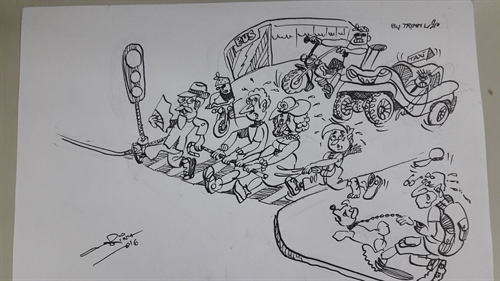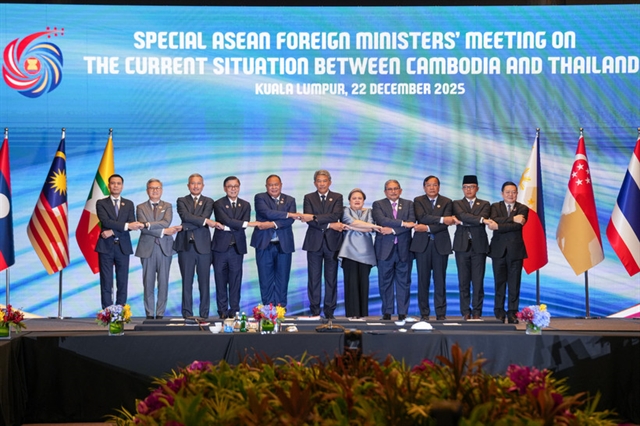 Talk Around Town
Talk Around Town

Much has been said and written about the travails of crossing the street in Việt Nam. Hotels hand out tip sheets to nervous tourists about navigating the endless swarms of seemingly unstoppable motorbikes clogging the streets, tour guides provide contradictory advice (one school of thought has it that it’s best to catch the eye of the motorcyclist bearing down on you in order to make him stop, another rejects this as nonsense).
 |
by Ruth Sinai
Much has been said and written about the travails of crossing the street in Việt Nam. Hotels hand out tip sheets to nervous tourists about navigating the endless swarms of seemingly unstoppable motorbikes clogging the streets, tour guides provide contradictory advice (one school of thought has it that it’s best to catch the eye of the motorcyclist bearing down on you in order to make him stop, another rejects this as nonsense). Guidebooks suggest simply walking confidently and the traffic “will morph around you” (probably the best idea).
And then there are the comedians. One expat offered this advice: “For the beginning crosswalk experience, try to find… an elderly person to walk with. If they’ve survived crossing the street for years and are still alive, they must know something.”
However, in addition to this perpetual game of chicken on the road, what very few people warn you about is the ordeal of walking on city sidewalks. For those of us raised on the notion that sidewalks, aka pavements, are designed for walking, in countries where walkers’ rights are virtually enshrined in the constitution, the experience of trying to make one’s way from point A to B is an exercise in disbelief.
Simply put, pedestrians are second class citizens.
Evolutionary speaking, homo erectus is considered to have a distinct advantage over less evolved creatures. Not so in Việt Nam, where those moving around on two wheels – rather than two legs - are indisputably masters of the realm.
Sidewalks are for everything, except walking. First and foremost, they are for motorcycle parking. Rows and rows of these two-wheeled machines line every sidewalk, and the few inches not taken up by them are taken over by the growing number of cars competing with them for parking spots.
Some of the bikes are simply parked. Others have varied uses – daybeds for those worn out by the debilitating heat, the head resting on the seat and legs over the handlebars. Others serve as a point of congregation for friends or work colleagues, creating further congestion on the already impassable sidewalks.
Then there’s the very considerable and varied sidewalk economy: the vendors squatting at every corner hawking exotic-looking fruit, peeled and cut, with a thin coating of motorbike fumes; the cauldrons of boiling soup with noodles and smoking grills laden with slabs of meat, offering Việt Nam’s much lauded “street food”; the makeshift barber chairs; the hosing down of dishes and pots used by the various eateries.
Some are official establishments, others are impromptu picnics on the sidewalks, with family and friends escaping crowded housing and the heat to lounge on mats or stools outside.
For those of us not agile enough to vault Olympic-style over the seated patrons, stepping off the curb onto the shoulder of the road is the only option.
Then there are the paving stones popping up at odd angles in a seemingly deliberate attempt to trip pedestrians. The well-intentioned attempts by authorities to repair the paving or to lay down underground fiber optic cables to replace the thick tangles of overheard electric and communication cables – result in intricate obstacle courses. Sidewalks crisscrossed by shallow tunnels, many turned into mini canals by the summer rains, and once again the only recourse is – yup, to step off the curb.
And we haven’t mentioned the trucks unloading merchandise and taking up the whole width of the sidewalk, the endless guard booths and policemen stationed outside every public building (of which there are many), and the security guards outside numerous shops, lounging on makeshift chairs, their legs splayed out in front of them in yet another hurdle to foot traffic.
After navigating this minefield for weeks, I didn’t know whether to laugh or cry at the following item reported by Việt Nam News.
“In an attempt to reduce traffic accidents in the city, Hà Nội police suddenly fined more than 100 pedestrians… after statistics showed that the city had 1,700 traffic accidents last year, 150 of which involved pedestrians.
“Pedestrians can now receive fines of VNĐ50,000 to 150,000 (US$2 to $7) if they are found walking in the road… designed only for vehicles.”
Excuse me? So it’s the pedestrians who are to blame? If they step off the curb because there’s nowhere else to go, they not only risk losing life and limb by being run over or sideswiped by vehicular traffic, they are also being punished financially?
The one bright spot can be found in Hà Nội’s weekend night market. For three evenings dozens of narrow roads in the city’s Old Quarter are closed off to vehicle traffic and pedestrians rule. That doesn’t stop some bikers from bobbing in an out of the walking hordes, but police are sometimes on hand to stop them, impose fines and confiscate their bikes.
Nearly 40 million motorbikes are registered in Việt Nam, translating to one for less than two adults. In the capital, there are nearly five million motorbikes for a population of 7.7 million.
The two-wheeled and the two-legged have to find a modus vivendi. Motorbikes are the backbone of the economy, culture and public life. But pedestrians have rights that must also be recognised. — VNS




